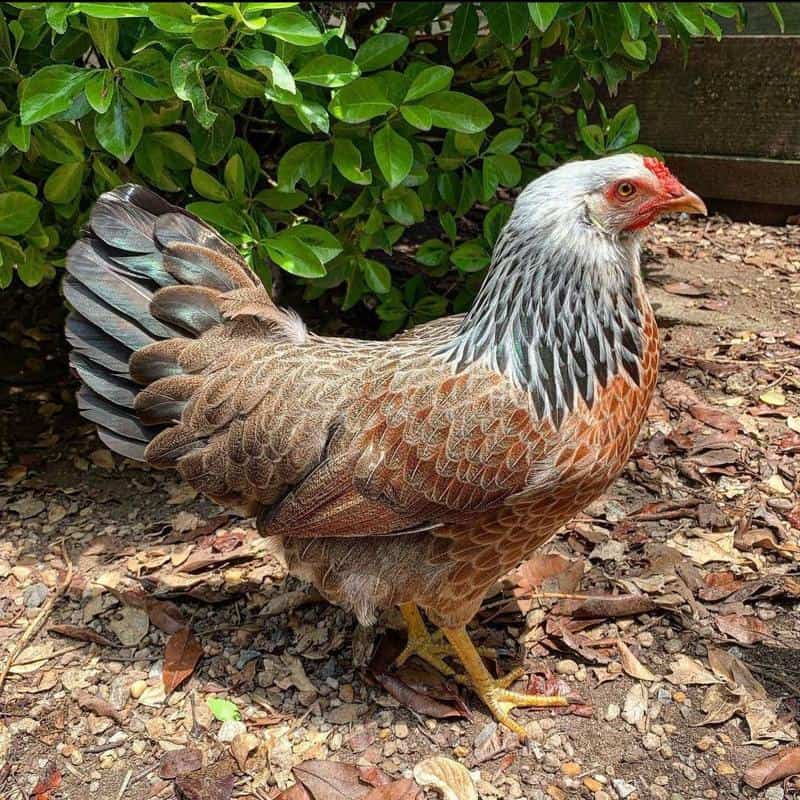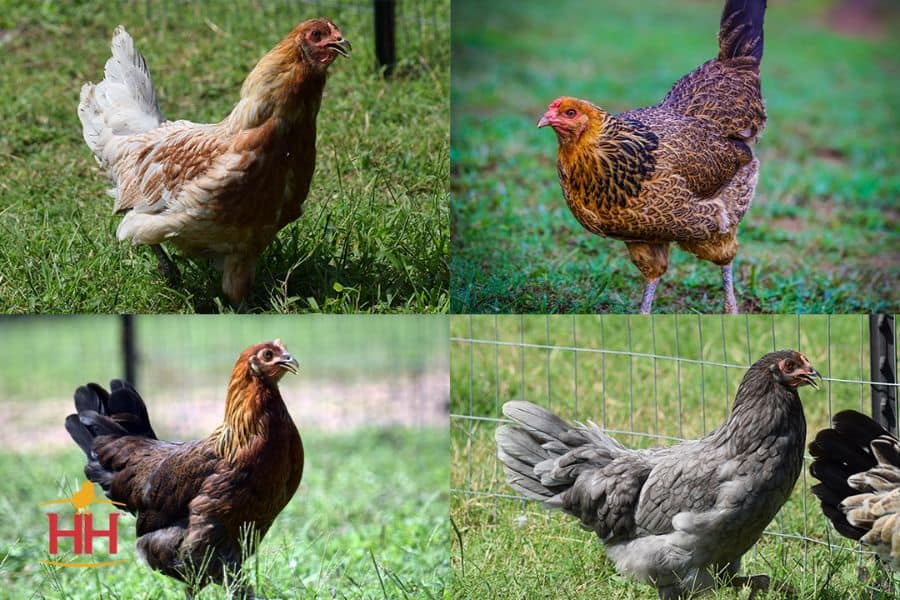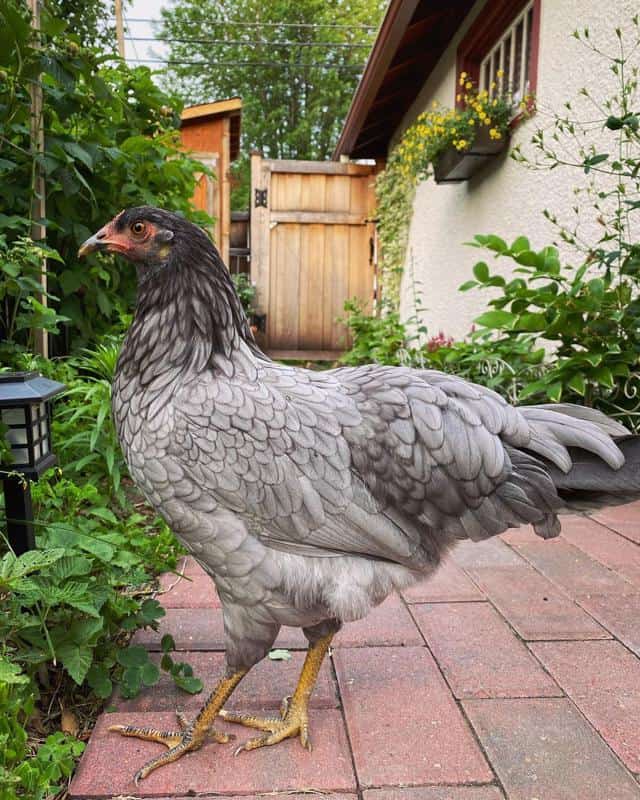The Prairie Bluebell Egger is a chicken that has been rising up the popularity charts in recent times. Its history only goes back to 2019, but the quality of its blue eggs has made it a must-have for many backyard farmers.
Because it’s so new, a lot is yet to be established about the Prairie Bluebell Egger. Many farmers haven’t owned this bird long enough to even gauge its lifespan.

Luckily, the heritage breeds from which the Prairie Bluebell Egger is bred have many attractive qualities and many of these qualities have been passed down to this bird. The result is a productive bird that also looks to be very beginner friendly.
If you’ve been interested in getting some blue eggs from your flock, the Prairie Bluebell Egger might be the bird for you. Read on to discover what this chicken is all about.
Prairie Bluebell Egger Quick Facts
| Names | Prairie Bluebell, Prairie Bluebell Egger |
| Origin | USA |
| Purpose | Egg Production |
| Egg Production/Year | 240 – 280 |
| Climate | Cold and Heat Hardy |
| Plumage Color | Variable |
| Weight | 4 – 5 pounds |
| Personality | Active, Curious, Friendly; Great fliers |
| Unique Fact | Some Prairie Bluebell chickens will lay white eggs. |
History of the Prairie Bluebell Egger
The Prairie Bluebell Egger is a hybrid chicken that is the result of crossing Araucana roosters and White Leghorn hens.
Araucanas are the original carriers of the blue egg gene and White Leghorns are known for their prolific egg-laying. The Prairie Bluebell Egger was, thus, expected to be a hybrid that would lay many blue eggs.
Hoover’s Hatchery in the United States is credited with the development of this hybrid. The company trademarked the name ‘Prairie Bluebell Egger’ in January 2019, the same year it was first used commercially.
Appearance of Prairie Bluebell Eggers
Size
The mature weight of Prairie Bluebell Eggers is between 4 and 5 pounds. This makes sense considering neither of its parent breeds are considerably large.
The most obvious downside of their small size is that these birds will not make good meat birds.
Plumage Color
Hoover’s Hatchery states that the plumage of these birds will vary considerably. Many farmers have experienced this phenomenon firsthand.
Plumage colors that have been reported include gray, splash, and white. Other Prairie Bluebell Eggers feature an intricate mix of colors that blend to create beautiful patterns as seen below.

Despite the beautiful results, the non-specific plumage color has made it difficult for some farmers to tell whether their chickens are indeed Prairie Bluebell Eggers or something else.
To avoid this problem, you should only source your Prairie Bluebell Eggers from a reputable hatchery.
Other Body Features
All Prairie Bluebell chickens have pea combs.
Since Leghorns have smooth faces and Araucanas don’t, Prairie Bluebells can either have smooth or fluffy faces.
Is the Prairie Bluebell Egger the Same as the Bluebell Chicken?
The Prairie Bluebell Egger is not the same as the Bluebell Chicken which is also known as Beechwood Blue.
The Bluebell Chicken is also a hybrid, but it is much heavier than Prairie Bluebell Eggers and lays brown eggs. It gets its name from its smokey blue plumage.
Egg Laying Potential of Bluebell Eggers
How Many Eggs Can the Prairie Bluebell Lay in a Year?
This hybrid can produce between 240 and 280 eggs in a year. The eggs are medium-sized, which is between 49.6 and 56.7 grams.
When do Prairie Bluebell Eggers Start Laying?
If you’re lucky, you may see your first blue egg from your Prairie Bluebell just 5 months after it hatches.
What Makes the Prairie Bluebell’s Eggs Special?
According to Hoover’s Hatchery, the quality of blue eggs from their chickens is higher than what you’d get from Araucana chickens.
Secondly, if you cross your Prairie Bluebell rooster with hens that don’t have the blue-egg gene, you could end up with offspring that produce egg colors like:
- Blue
- Olive
- Green
- Peach
- Brown
These colors will show up in different intensities depending on the genes carried by the rooster and the hen.
When Does Egg-Production Decline in Prairie Bluebell Chickens?
A common phenomenon in layer hybrids is that they lay a high number of eggs in the first two years before their production rate drastically declines.
However, the Prairie Bluebell Egger is a very new hybrid. Having been introduced to the market in 2019, it’s not possible to know in 2023 what the long-term egg-laying potential of this hybrid is.
Are Blue Eggs Guaranteed from Prairie Bluebell Chickens?
Unfortunately, you are not guaranteed that your Prairie Bluebell will produce blue eggs, or even colored eggs for that matter.
If your chicken is the offspring of two Prairie Bluebell chickens that both carry only one blue-egg gene, there’s a 25% chance it will be laying white eggs.
Raising Prairie Bluebell Egger Chickens
Housing and Environment
These hybrid chickens are hardy and can cope well with both heat and cold as seen in the video below. This makes them a good option for North American backyard farmers.
As with any hardy breed, you should still take precautions to protect them from temperature extremes such as heat waves and cold snaps.
Due to their active nature, space is an important consideration if you choose to get a Prairie Bluebell Egger. It is best if these birds are allowed to free range.
If you don’t have the space for your chickens to free range, ensure they have plenty of space inside their run.
Prairie Bluebells have considerable flying ability so you’ll either need a covered run or a high fence to keep them in. Some owners have been unable to contain these birds even with 7-foot-tall fencing.
Diet
One advantage of keeping Prairie Bluebell Eggers is that their small size means they don’t consume a lot of feed. Secondly, they also like to forage and might even prefer what they find in the wild to the feed you provide.
Feed is one of the costliest expenses when raising chickens and these two factors mean you can save a lot of money by keeping Prairie Bluebell Eggers.
On the other hand, the high number of eggs produced by these chickens means you should still ensure your chickens are getting a nutritionally balanced diet. This will ensure your bird’s health does not suffer due to the demands of producing eggs.
Temperament
Prairie Bluebell Egger chickens have been described as active, curious, and extremely friendly. These are the qualities you want in a chicken, especially if you’re new to chicken farming.
Even if they don’t get much human interaction, Prairie Bluebells won’t cause you much trouble. However, if you want a pet chicken, playing with the chicks will make them a lot more eager to interact with you when they mature.
Prairie Bluebell Eggers are also very alert. Any predator prowling in your backyard hoping to eat these chickens will have a tough time sneaking up on them.
Health Concerns and Lifespan
Bluebell chickens have not exhibited a higher or lower level of susceptibility to common poultry diseases compared to typical heritage breeds.
At this point in time, data on the lifespan of these chickens is also lacking due to the newness of this hybrid.
Breeding Prairie Bluebell Egger Chickens

Breeding Challenges
Getting offspring with the blue-egg gene from the Praire Bluebell Egger is not a straightforward process. The challenges you face include:
- Rarely broody hens: Prairie Bluebell hens don’t like to sit on eggs. You’ll have to hatch their eggs in an incubator or find a surrogate hen.
- They are hybrids: This means there is no guarantee the chicks you get from your Prairie Bluebell will have the same qualities as the parents. Depending on the genetic makeup of the parents, you may end up with offspring that lay regular white eggs.
- Availability: Prairie Bluebells were developed quite recently. Getting a pair that is right for breeding might be an uphill task.
However, it’s not all doom and gloom. You can still guarantee that you will get offspring carrying the blue egg gene if you have a rooster that carries two blue egg genes.
Prairie Bluebell roosters are also highly sought after because crossing them with other chickens can result in hens that produce a wide range of interesting egg colors.
For example, a Prairie Bluebell rooster crossed with a breed that lays brown eggs can give you a hen that lays olive-colored eggs.
Are Prairie Bluebell Eggers Sex-Linked?
Prairie Bluebell Egger chickens are not sex-linked. This means that the males cannot be reliably differentiated from the females soon after hatching.
It’s not uncommon for customers to get a Prairie Bluebell rooster chick when they order a hen. Some retailers will give you store credit on such purchases or replacement pullets.
Read More: Blue Laced Red Wyandotte
All the Blue Eggs You’ll Need
The Prairie Bluebell Egger is a new hybrid that promises some of the best blue eggs you’ll come across. This beginner-friendly breed comes in all plumage colors and is a relatively small bird.
Although its eggs are only regular-sized, Prairie Bluebells can lay as many as 280 of these eggs in just one year.
Prairie Bluebell Eggers don’t require much attention and are happy to forage for their food. They are exceptional fliers though and you may want to take measures to keep them from flying too far.
This hybrid is not sex-linked, and you’re not guaranteed any specific egg color when you purchase a chick. However, they have a personality that will charm most backyard farmers.
This is a hardy hybrid that is easy to recommend to someone that’s starting out in chicken farming. If you get your hands on the right birds, you may be treated to an assortment of beautiful egg colors every morning.
